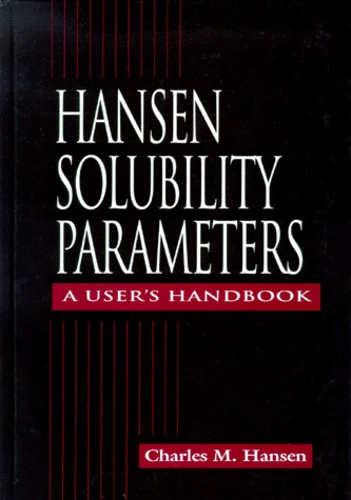Hansen Solubility Parameters. A User'S Handbook
Par :Formats :
Définitivement indisponible
Cet article ne peut plus être commandé sur notre site (ouvrage épuisé ou plus commercialisé). Il se peut néanmoins que l'éditeur imprime une nouvelle édition de cet ouvrage à l'avenir. Nous vous invitons donc à revenir périodiquement sur notre site.
- Nombre de pages208
- PrésentationRelié
- Poids0.6 kg
- Dimensions18,5 cm × 26,0 cm × 1,8 cm
- ISBN0-8493-1525-5
- EAN9780849315251
- Date de parution12/11/1999
- ÉditeurCRC Press
Résumé
Charles M. Hansen began his work with solvents in 1962, and almost immediately began producing new and groundbreaking results. Since then, his Hansen Solubility Parameters have been extensively used and proven valuable to a variety of industries. They allow correlations and systematic comparisons previously not possible, such as polymer solubility, swelling, permeation, surface wetting and dewetting, solubility of organic salts, and many biological applications. Until now, however, their seemingly universal ability to predict molecular affinities has been generally taken as semiempirical. Moving beyond the Hildebrand and Flory theories, Hansen found that his approach not only quantitatively describes hydrogen bonding and polar bonding in many types of systems, but in fact agrees with and extends the very general Prigogine theory. This explains why the correlations all seem to fit with an apparently "universal" 4. Hansen Solubility Parameters provides new tables of previously unpublished correlations and parameters. The author illuminates the text with practical examples relating to coatings, biological systems, pigments and fibers, and takes a general approach that makes this reference ideal for predicting compatibility, adsorption on surfaces, orientation toward materials of similar affinities (self-assembly), and other phenomena associated with solubility and affinity. Chemical engineers, chemists, and biochemists will find this book- the collected work and experience of the father of its concept - intriguing for its theory and invaluable for its data.
Features
• Contains previously unpublished tables of correlations and parameters
• Discusses the theory behind the validity and development of the parameters
• Includes practical examples relating to uses of solvents and polymers, biological systems, pigments, fibers, and more
• Offers an authoritative, fundamentally innovative, yet simple approach
• Serves as a "how to" book
Charles M. Hansen began his work with solvents in 1962, and almost immediately began producing new and groundbreaking results. Since then, his Hansen Solubility Parameters have been extensively used and proven valuable to a variety of industries. They allow correlations and systematic comparisons previously not possible, such as polymer solubility, swelling, permeation, surface wetting and dewetting, solubility of organic salts, and many biological applications. Until now, however, their seemingly universal ability to predict molecular affinities has been generally taken as semiempirical. Moving beyond the Hildebrand and Flory theories, Hansen found that his approach not only quantitatively describes hydrogen bonding and polar bonding in many types of systems, but in fact agrees with and extends the very general Prigogine theory. This explains why the correlations all seem to fit with an apparently "universal" 4. Hansen Solubility Parameters provides new tables of previously unpublished correlations and parameters. The author illuminates the text with practical examples relating to coatings, biological systems, pigments and fibers, and takes a general approach that makes this reference ideal for predicting compatibility, adsorption on surfaces, orientation toward materials of similar affinities (self-assembly), and other phenomena associated with solubility and affinity. Chemical engineers, chemists, and biochemists will find this book- the collected work and experience of the father of its concept - intriguing for its theory and invaluable for its data.
Features
• Contains previously unpublished tables of correlations and parameters
• Discusses the theory behind the validity and development of the parameters
• Includes practical examples relating to uses of solvents and polymers, biological systems, pigments, fibers, and more
• Offers an authoritative, fundamentally innovative, yet simple approach
• Serves as a "how to" book

